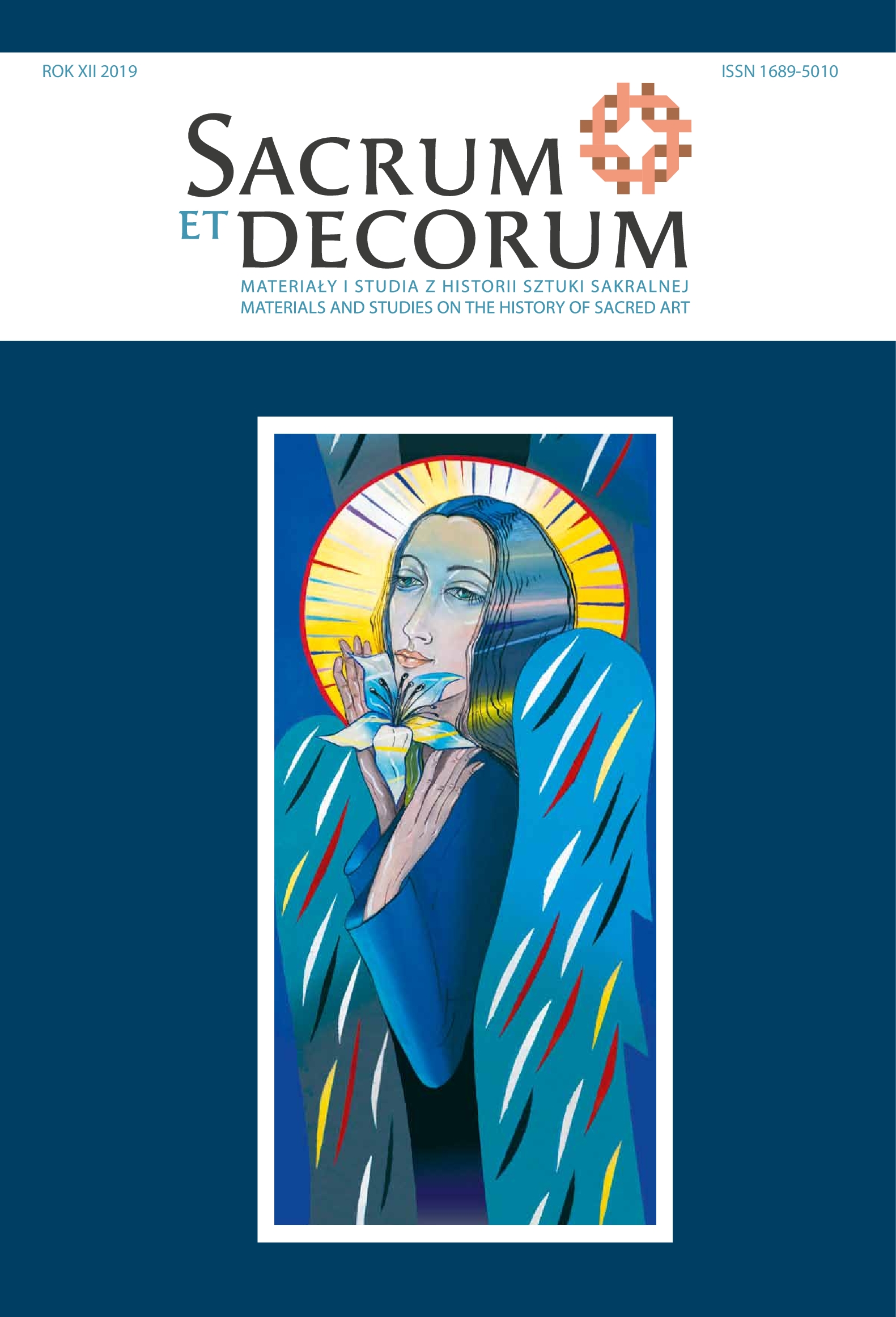Figura Dobrego Łotra w najnowszej realizacji artystycznej Adama Brinckena i Macieja Zychowicza
Słowa kluczowe:
rzeźba, malarstwo, Adam Brincken,, Maciej Zychowicz, Akademia Sztuk Pięknych, w Krakowie, Pasja, Dobry ŁotrAbstrakt
„Dziś będziesz ze Mną w raju” (Łk 23, 43) – słowa Chrystusa skierowane do jednego z ukrzyżowanych z Nim łotrów stały się tematem najnowszej realizacji wykonanej przez krakowski zespół artystów pod kierownictwem malarza Adama Brinckena i rzeźbiarza Macieja Zychowicza. Jesienią roku 2017 wykonali oni dekorację prezbiterium kościoła pw. św. Kazimierza w Bilczy koło Kielc wyobrażającą rozmowę Ukrzyżowanego z Dobrym Łotrem. Na wyposażenie składają się monumentalna grupa rzeźbiarska ukazująca Golgotę, ograniczona malarską formą przypominającą kształt pojedynczej steli, a także abstrakcyjny witraż ulokowany w niewielkim otworze okiennym (wyk. Krystyna i Bogusław Szczekan, Pracownia Artystyczna Witraży). Artykuł omawia oryginalnie zinterpretowany schemat ikonograficzny: dwa motywy, łączące się integralnie z przesłaniem słów Chrystusa – odpuszczeniem grzechów i obietnicą zbawienia. W świetle emanującym od Zbawiciela oraz w kontekście zapowiedzi zmartwychwstania ciał należy postrzegać pełnoplastycznie oddane partie ciała Dobrego Łotra. Natomiast wizerunek Chrystusa, wbrew chronologii narracji ewangelicznej, odczytywać trzeba jako Ukrzyżowanego i jednocześnie Zmartwychwstałego, gdyż Jego ciało nie nosi śladów cienia śmierci. Analizie poddano formalną stronę dekoracji malarsko- rzeźbiarskiej na tle innych tego rodzaju przedstawień pasyjnych i typów Dobrego Łotra. Dzieło Brinckena i Zychowicza zaprezentowano w kontekście wcześniejszych tego typu realizacji sakralnych. Pascha Chrystusa, rozumiana jako jedność wydarzeń Jego męki, śmierci i zmartwychwstania, związana ściśle z najistotniejszym dokonaniem Vaticanum II – odnową liturgiczną – była kilkakrotnie tematem wiodącym w pracach artystów. W żadnej jednak z nich nie wybrzmiały słowa Zbawiciela skierowane do Dobrego Łotra. W Bilczy stały się one tematem przewodnim, stanowiąc niejako echo dla wielu współczesnych refleksji obejmujących problematykę Miłosierdzia Bożego.Downloads
Bibliografia
Muzeum / El Greco’s Ars Sacra – In the 100th Anniversary of the Independence and of the Museum / Ars Sacra El Greca – Centenario de la Independencia y del Museo, katalog wystawy, Muzeum Diecezjalne w Siedlcach, 11.10.2018–31.01.2019, red. ks. R. Mirończuk, Siedlce 2018, s. 102–149.
Pieńkos A., Tracona moc obrazu, czyli epizody nowoczesnego realizmu, Warszawa 2012.
Płazowska A., V.I. Stoichita, „Krótka historia cienia”, Kraków 2001 (omówienie i recenzja), „Modus. Prace z historii sztuki” 2002, nr 3, s. 93–97.
Rogozińska R., Taniec do nieba, „Rzeźba Polska”, t. VIII: 1996–1997 („Figuracja w rzeźbie polskiej XIX i XX wieku”), Centrum Polskiej Rzeźby w Orońsku, Orońsko 1999, s. 125–146.
Rogozińska R., W stronę Golgoty. Inspiracje pasyjne w sztuce polskiej w latach 1970–1999, red. H. Hilbert, Poznań 2002.
Roth E., Das volkreiche Kalvarienberg in Literatur und Bildkunst des Spätmittelalters, Berlin 1967.
Ryba G., Droga krzyżowa. Przestrzeń sakralna i sakralizacja przestrzeni we współczesnych realizacjach rzeźbiarskich / Stations of the Cross. The sacred space and space sacralisation in the context of modern sculptural achievements, „Sacrum et Decorum. Materiały i Studia z Historii Sztuki Sakralnej” VII (2014), s. 37–44.
Schiller G., Ikonographie der christlichen Kunst, cz. 2: Die Passion Jesu Christi, Gütersloh 1968.
Stoichita V.I., Krótka historia cienia, tłum. P. Nowakowski, oprac. red. A. Baranowa, Kraków 2001.
Tajemnica i forma. Adam Brincken. Malarstwo abstrakcyjne w przestrzeniach sakralnych / Mystery and Form. Adam Brincken – Abstract Painting in Sacral Spaces, oprac. A. Brincken, Kraków 2015.
Tejkl J., Nové poznatky o vztahu Braunovy dílny k sochařské tvorbě ve východních Čechách, w: Matyáš Bernard Braun 1684–1738. Sborník vědecké konference v Praze 26. a 27. listopadu 1984, red. Freimanová Milena, Praha 1988, s. 121–129.
Tes A., Obecne, kontemplacyjne, tworzące. O sposobach przejawiania się światła we współczesnym polskim malarstwie abstrakcyjnym, „Ethos. Kwartalnik Instytutu Jana Pawła II KUL” 30, 2017, nr 3(119), s. 258–259.
Ujma M., Figuracja. Garść refleksji, „Rzeźba Polska”, t. VIII: 1996–1997 („Figuracja w rzeźbie polskiej XIX i XX wieku”), Centrum Polskiej Rzeźby w Orońsku, Orońsko 1999, s. 9–18.
Wisłocki M., Sztuka protestancka na Pomorzu 1535–1684, Szczecin 2005.
Wojciechowski L., Drzewo Przenajszlachetniejsze. Problematyka Drzewa Krzyża w chrześcijaństwie zachodnim (IV – połowa XVII wieku). Od legend do kontrowersji wyznaniowych i piśmiennictwa specjalistycznego, Lublin 2003.
Wójtowicz K., Emaus programem formacji seminaryjnej. Próba pastoralno-estetycznego odczytania tryptyku z kościoła pw. Emaus w Centrum Resurrectionis w Krakowie, „Zeszyty Historyczno-Teologiczne. Rocznik Collegium Resurrectianum” XII, 2006, nr 12, s. 21–35.
Wójtowicz K., Emaus programem formacji seminaryjnej, Kraków 2006.
Zychowicz M., Czas twórcy, czas dzieła, [w:] Fides ex visu, red. R. Knapiński, A. Kramiszewska, Lublin 2011, s. 90–92.
www.maciej-zychowicz.pl
www.architektura7dnia.pl
www.witrazeartystyczne.pl
Pobrania
Opublikowane
Jak cytować
Numer
Dział
Licencja
Prawa autorskie (c) 2019 Sacrum et Decorum

Utwór dostępny jest na licencji Creative Commons Uznanie autorstwa – Użycie niekomercyjne – Bez utworów zależnych 4.0 Międzynarodowe.
Zgodnie z polityką Open Access autorzy zachowują pełnię praw autorskich do swoich artykułów – bez ograniczeń.
Autorzy mogą deponować swoje artykuły w wybranym przez siebie repozytorium.


